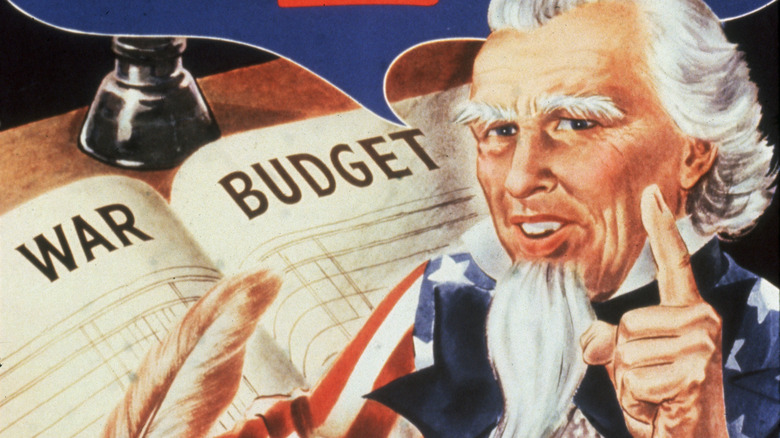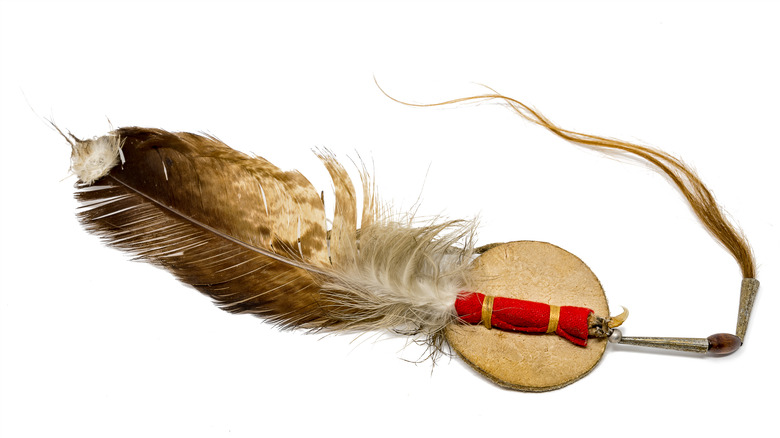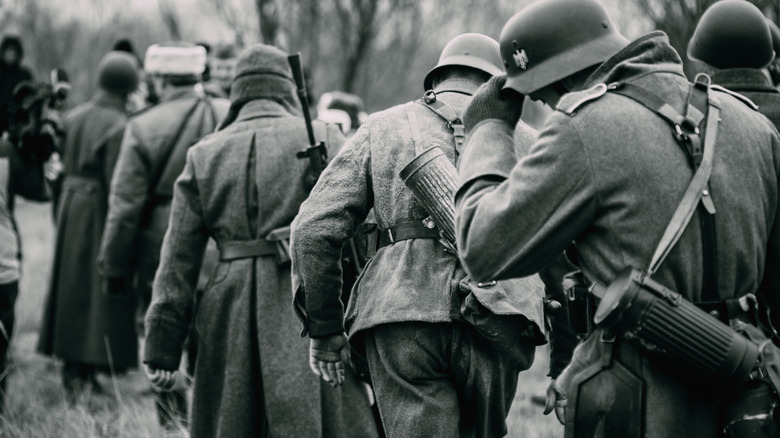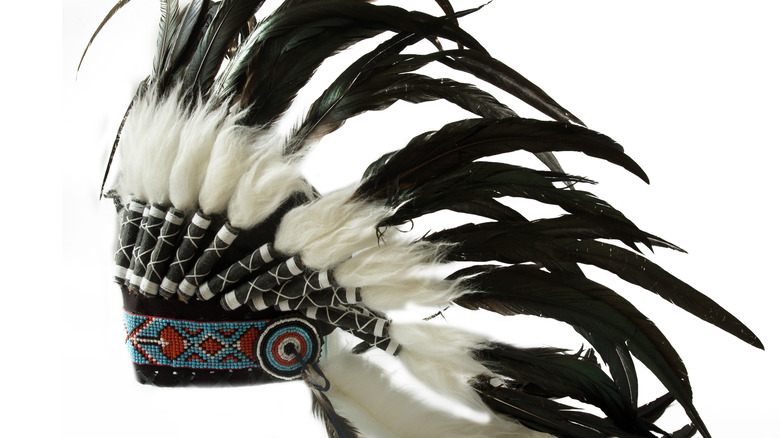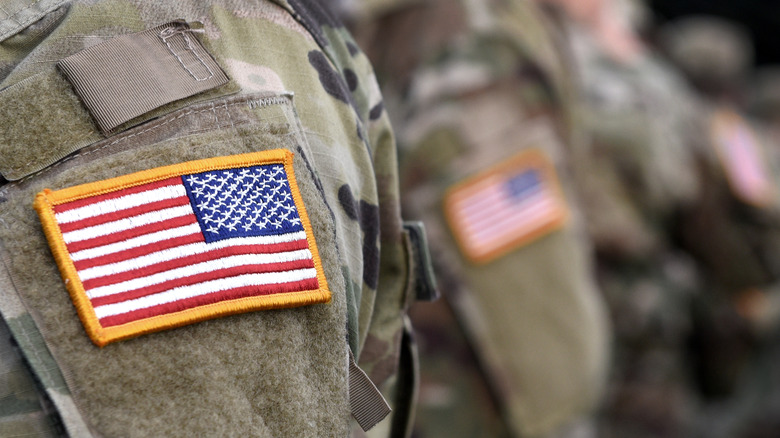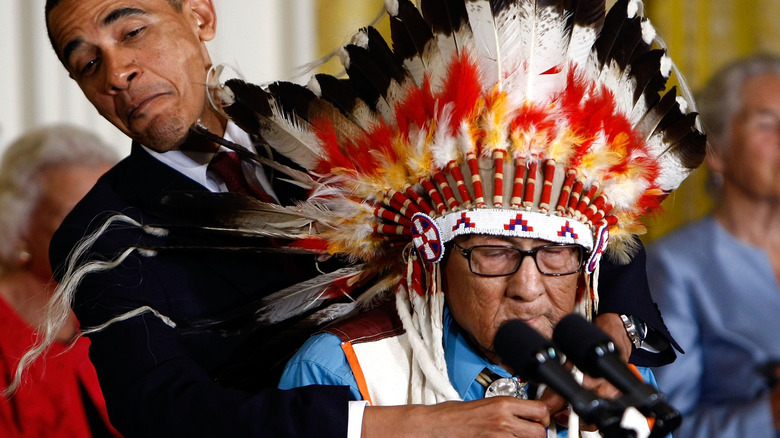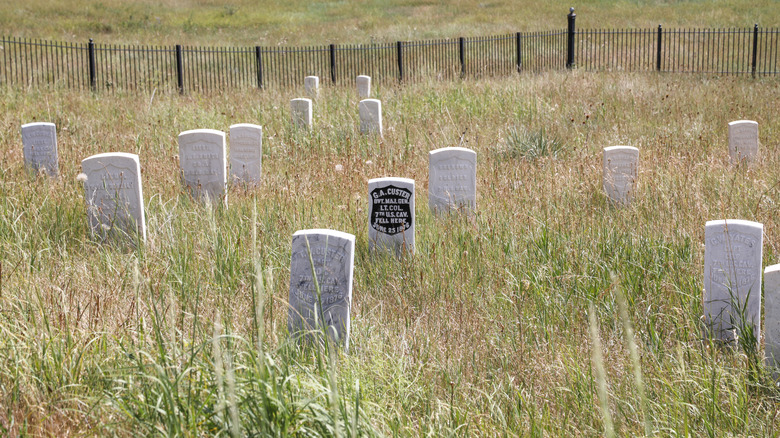The Untold Truth Of Joe Medicine Crow
Born in 1913 near Lodge Grass, Montana, Joe Medicine Crow grew up surrounded by vaunted Crow warriors, and he avidly soaked up their traditions (via Military). His paternal grandfather was Chief Medicine Crow, who first went into battle at 15 and would continue to see action until his last fight in 1877, per Little Big Horn College. According to the Public Broadcasting Service, his step-grandfather, White Man Runs Him, scouted for Lieutenant Colonel George Armstrong Custer at the Little Bighorn, providing firsthand accounts of the military blunders that precipitated the massacre.
His close connections with celebrated Crow warriors meant a unique early education by today's standards. Moving well beyond the ABCs and basic arithmetic, he mastered how to survive Montana's notoriously frigid winters and how to ride bareback. Elders of his tribe also helped him overcome fear in the pursuit of bravery and taught him to hunt. Medicine Crow avidly devoured the legends of the great warriors who had come before him, warring against the Lakota and the Cheyenne.
A significant component of the traditional Crow warrior life involved completing "four feats of valor" (via ATI). These feats included aspects of traditional warfare like stealing horses and counting coups. Only by achieving these four acts did a warrior become a Plains war chief. But the Crow had long been confined to reservations, and inter-tribal warfare had ceased, making the fulfillment of this ancient tradition appear impossible.
He was the first Crow to obtain a master's degree
Growing up steeped in the legends and lifeways of his people inspired Joe Medicine Crow to pursue higher education (via World Wisdom). He became the first Crow nation student to seek a post-graduate degree. He submitted a thesis entitled, "The Effects of European Culture Contact upon the Economic, Social, and Religious Life of the Crow Indians," to secure a Master of Arts in Anthropology from the University of Southern California in 1939, per Military.
As the title suggests, in his thesis, Medicine Crow explores how the daily lives and beliefs of the Crow transformed under the pressures of cultural assimilation. But the work doesn't stop there. It also provides essential insights into other Native American groups in Montana and greater North America, all within the context of cultural exchange with Euro-Americans. Scholars researching the life and times of the Crow still look to this work today to gain a deeper appreciation of the different aspects of the tribe's culture.
After this smashing success, Medicine Crow decided to continue at USC with a doctorate degree. But life got in the way, in the form of an arrogant, mustached Austrian-turned-German dictator with designs on conquering the globe. After Japan's surprise attack on Pearl Harbor ushered the United States into a war of planetary proportions, Medicine Crow received the call to fight. Or, as he put it, "My uncle had other plans for me ... Uncle Sam that is," per the Custer Museum.
He contributed to our understanding of Custer's Last Stand
White Man Runs Him gifted his step-grandson, Joe Medicine Crow, with intimate knowledge about his time scouting for Lieutenant Colonel George Armstrong Custer and the events that precipitated the U.S. military disaster on June 25 and 26, 1876, at the Little Bighorn. But his grandfather's firsthand account didn't jive with the official narrative (via PBS).
White Man Runs Him claimed Lieutenant Colonel George Armstrong Custer's men had been drinking that day and weren't battle-ready (via True West Magazine). He said Custer's Crow scouts warned him not to attack the village because of its vast size. Yet, Custer ignored them. White Man Runs Him's account proves far from the varnished presentation of movies like 1941's "They Died With Their Boots On," which spin the narrative into the American version of the 300 Spartans at Thermopylae. Ironically, Medicine Crow answered an ad for extras to appear in the Errol Flynn flick only to get turned away because of his step-grandfather's less-than-heroic take on the Lieutenant Colonel.
After all, during World War II, America wanted to flex its military might, not revisit a foolhardy expedition. But Medicine Crow would have the last laugh in 1965. As the last surviving person who benefited from a "direct oral account" of Custer's "Last Stand," Medicine Crow wrote a script of the events still used each year during the Battle of the Little Bighorn re-enactment in Hardin, Montana, as reported by the National Park Service.
Joe Medicine Crow incorporated traditional Crow warfare into modern battle
Sure, Joe Medicine Crow fought in a war where tanks ruled the ground and airplanes the sky, but this didn't stop him from incorporating traditional aspects of Crow warfare into his daily routine, per the Billings Gazette. According to the Mountain Home Air Force Base, Medicine Crow would credit these traditional practices with saving his life on numerous occasions on the battlefield.
According to the Washington Post, he always painted himself with war paint (hidden beneath his uniform) before heading into battle. What's more, he carried an eagle feather (given to him by a medicine man during a Sun Dance) into battle inside his helmet (via PBS). According to the medicine man, the feather would shield him from danger.
The paint that Medicine Crow wore under his uniform also contained sacred significance. As reported by Powwows, "This paint would have been prayed over. It was believed that Indians' prayers were put into the paint, and when applied, the power of the prayers was conveyed upon the wearer." On the brutal battlefields of World War II, these items would have proven not only evocative of his home but also emboldening in the face of ruthless Nazi combatants.
He completed his 'four feats of valor' during World War II
Since the introduction of horses to the Plains by the Spanish, Crow warriors had gone through a series of four steps to become war chiefs, per Military. But achieving these feats seemed impossible once the tribes moved to reservations. These feats included leading a war party to victory, stealing the opposition's horse, taking an enemy combatant's weapon, and counting coups by touching a living, breathing opponent, as reported by the NPS.
Passing each of these traditional tests looked unattainable within the context of daily life in pre-war America. But the battlefields of Europe offered Joe Medicine Crow the opportunities he needed to become a celebrated war chief. His death-defying heroics would become the stuff of new legends.
They included counting coups on a German soldier he ran into in an alleyway during an attack on a German city; he managed to both disarm and capture the soldier. But the heroics didn't stop there. Medicine Crow led seven troops on a veritable suicide mission to secure dynamite from a destroyed American position. He then used the captured explosives to charge the enemy, blowing a hole in the Siegfried Line and the Nazi guns thwarting an American advance (via Mountain Home Air Force Base). Despite braving artillery fire, landmines, and overwhelming enemy numbers, Medicine Crow and his men came through without a scratch. Fate and courage helped Medicine Crow complete the first three "feats of valor" (via ATI) almost unintentionally, as reported by PBS.
Joe Medicine Crow found a way to steal horses in Europe
Yet, one task still evaded him — stealing the horse of an enemy from their camp (via NPS). Without this, he would never become a full-fledged Crow war chief. Fortunately, World War II represented a confluence of military technologies, some old and some new. According to Military History Now, this included the use of cavalry to transport artillery.
As luck would have it, Medicine Crow's infantry would eventually catch up with a group of Nazi SS troops fleeing with a caravan of 50 horses, providing an unlikely opportunity to complete his final task, per the Economist. Medicine Crow discovered the contingent of horses while on a scouting mission to search the area for Nazi soldiers, and he realized he had to sneak in and steal them.
After getting the okay from his commanding officer, he snuck out in the wee hours of the morning, slipping right past the guards sleeping around the encampment (via Military). After selecting the finest horse in the herd, he jumped on its unsaddled back, using a rope as a makeshift bridle. Herding the other horses to head out with him, he let out an ear-shattering "Crow war cry," escaping into the countryside with the Nazis' only means of transportation. As SS officers raced outside in their skivvies firing clumsy shots off at the man riding swiftly into the distance, Medicine Crow punctuated his triumph with a traditional Crow war song.
He was decorated as the last Plains war chief
With the end of the war in 1945, Joe Medicine Crow returned home triumphant (via Billings Gazette). As was the custom among his people, he recited his war deeds to the community, covering everything from his face-to-face encounter with a German soldier to his dash behind enemy lines to take horses. For the Crow, certain actions like touching a living enemy ranked more highly than killing, and so these stories brought him great prestige, per Plains Humanities.
But he gained more than a reputation through the retelling of his war experiences. The elders of Medicine Crow's tribe realized he had completed the "four feats of valor" (via ATI) necessary to gain entry to that distinguished group of individuals known as Plains war chiefs. According to Military, they honored him with this title, making him the last man of the Plains tribes to ever receive this tribute.
This war distinction acknowledged Medicine Crow's exemplary bravery and performance in warfare and recognized his leadership potential within the community. It would be just one of many awards and accolades that he would receive for his death-defying actions during World War II.
Joe Medicine Crow gained renown as an academic
Joe Medicine Crow transitioned back into civilian life, working as a historian of the Crow Tribe (via the National Library of Medicine). He gained esteem for his many books and documentaries about the Battle of the Little Bighorn, and he actively sought to pass the traditions of his people on to the next generation.
He would receive honorary doctorate degrees from the University of Southern California and Rocky Mountain College for his numerous and significant academic contributions. In 2010, Bacone College also honored him. According to World Wisdom, Medicine Crow was a sought-after public speaker often featured at the Custer Battlefield Museum and Little Bighorn College. He also accepted speaking engagements at other institutions throughout the country, gifting students with his unique knowledge of the American West, according to True West Magazine.
Medicine Crow's nearly dozen published books also contribute to the history of the American West, per Custer Museum. His most well-known tomes include "From the Heart of the Crow Country" and "A Handbook of Crow Indian Laws and Treaties." And he also contributed forwards, introductions, and features to other scholarly works like "Custer's Last Battle: Red Hawk's Account of the Battle of the Little Bighorn" and "Living in Two Worlds: The American Indian Experience."
His nephew nearly secured the same 'four feats of valor' in Vietnam
Although Joe Medicine Crow holds the distinction for being the last Crow warrior to achieve all "four feats of valor" (via ATI), another member of his family came about as close as you could get (via Billings Gazette). During the Vietnam War, Medicine Crow's nephew Carson Walks Over Ice managed three requirements while serving as a Green Beret, according to Dr. Herman J. Viola's "Reflections" podcast. He also wore two medallions blessed by others in the tribe that he believed shielded him in battle like his uncle.
As a Green Beret, he often got dropped behind enemy lines. Because the Viet Cong proved exceptional at identifying and killing commanding officers, Sergeant Walks on Ice removed his insignias in battle. Instead, he wore an eagle feather in netting on his helmet, identifying him to his troops.
Like his Uncle Joe Medicine Crow, Walks on Ice sought to complete the "four feats of valor." But getting his hands on an enemy horse proved challenging. He carried a rope in his pocket just in case, but the opportunity to nab an equine never arrived. However, he did manage to capture a couple of war elephants loaded with guns and ammunition from an enemy combatant along the Ho Chi Minh Trail. Unfortunately, pachyderms didn't count, according to Crow elders. But the elders did give him credit for leading many successful war parties without losing a man.
Joe Medicine Crow received countless honors for bravery
On June 15, 2008, at the Tomb of the Unknown Soldier in front of the Custer Battlefield Museum in Garryowen, Montana, Joe Medicine Crow received the Bronze Star and the French Legion of Honor Chevalier medal (via the Custer Museum).
Designed by Napoleon and first gifted in 1802, the Legion of Honor goes to individuals of the highest merit. Pierre Vimont, the French Ambassador to the United States, wrote of the honor, "It is a sign of France's true and unforgettable gratitude and appreciation for your personal, precious contribution to the United States' decisive role in the liberation of our country during World War II." The award comes in levels of degree. Medicine Crow received the Knight of the Legion of Honor, a degree enjoyed by other iconic WWII figures like Douglas MacArthur and Dwight Eisenhower.
In 2009, Joe Medicine Crow received national recognition for his incredible bravery and achievements again. President Barack Obama invited him to the White House, where he awarded him the Medal of Freedom, as reported by Obama White House. Remarkably, despite his advanced age of 95, he still headed up the ceremonial dance that punctuated the ceremony, per Military.
He didn't romanticize warfare in his work
Although Joe Medicine Crow received many honors for his warrior feats, he never romanticized battle in his academic work, as reported by the NPS. He said of the Battle of the Little Bighorn (and more generally war), "No One wins. Both sides lose. The Indians, so-called hostiles, won the battle of the day but lost their way of life. The worst enemies are ourselves."
A theme running throughout the work and actions of Medicine Crow was that of healing. What Medicine Crow did at the groundbreaking ceremony commemorating the Indian memorial at the Little Bighorn best exemplifies his beliefs. According to Historian Paul Andrew Hutton (in an interview with True West Magazine), while working on the advisory commission for the monument, Hutton and his fellow board members worked diligently to avoid using the name of Lieutenant Colonel George Armstrong Custer. They hoped to eradicate all traces of the controversial military commander.
But during the ceremony, Medicine Crow jumped up from the crowd in his full World War II regalia. He walked up to Leonard Bruguier, head of American Indian Studies at the University of South Dakota, who had just finished giving a speech. Declaring that he would sing a song of honor for Custer, Medicine Crow delivered the lyrics in Crow and English, bringing a generous infusion of reconciliation to the ceremony.
He outlived most of his generation
Despite leading an adventurous life that involved plenty of risks, especially during the war years, Joe Medicine Crow lived to the ripe old age of 102, as reported by the Associated Press. He died in 2016, leaving behind a decorated legacy.
It's hard to quantify all the changes he witnessed throughout his life. But he once noted, "When I was born, on October 27, 1913, there were no doctors or nurses around with their instruments, just a medicine woman who specialized in child delivery." Raised by his grandparents in a rustic log house on an isolated portion of the Crow Reservation, he enjoyed the childhood of a bygone era, nurtured by the ancient traditions of his people.
Because of his long life, he also outlived most of his generation. After all, centenarians make up less than 1% of the American population, placing Medicine Crow in a class of his own (via Discover the Odds). Today, of the 16 million U.S. citizens who served in World War II, just 240,329 remain, and they're passing away rapidly, according to the National WW2 Museum. With each loss comes a loss of history. Fortunately, Medicine Crow's exploits prove well-documented, providing a template of exceptionalism for warriors of all ages.

